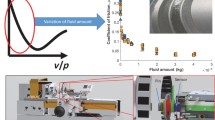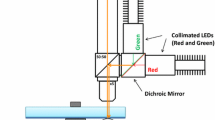Abstract
The effect of surface pattern on frictional characteristics of lubricated contact is studied. An algorithm based on the load-sharing concept is developed which assumes that the total transmitted load is carried by the asperities as well as the fluid film. Surface roughness for specified values of surface pattern number is generated assuming a Gaussian height distribution and Stribeck-type curves are obtained for isotropic, transverse, and longitudinal surfaces. The predictions of the model are verified by comparing published results on non-conformal contact of rollers and also a heavily loaded, conformal pin-bushing assembly. The results reveal that surfaces with transverse pattern generate larger friction than those with longitudinal surfaces. Transverse surfaces perform a higher film-forming capacity compared to isotropic and longitudinal surfaces.











Similar content being viewed by others
Abbreviations
- b :
-
Hertzian half-width of contact (m)
- B :
-
Pin-bushing length (m)
- c :
-
Clearance (m)
- D sum :
-
Density of asperities (1/m2)
- E(x):
-
Expectation of x
- E b :
-
Young’s modulus of bushing (N/m2)
- E s :
-
Young’s modulus of shaft (N/m2)
- E p :
-
Equivalent Young’s modulus (N/m2)
- f :
-
Friction coefficient
- f c :
-
Friction coefficient between asperities
- F C :
-
Load carried by asperities (N)
- F f :
-
Friction force (N)
- F f,H :
-
Friction force due to hydrodynamic film (N)
- F f,c :
-
Friction force due to asperity contact (N)
- F H :
-
Load carried by hydrodynamic film (N)
- F T :
-
Total load (N)
- h :
-
Film thickness (m)
- H c :
-
Non-dimensional film thickness
- L :
-
Lubrication number
- m 0 :
-
Zeroth moment of the surface
- m 2 :
-
Second moment of the surface
- m 4 :
-
Fourth moment of the surface
- m :
-
Index for auto-correlation function
- n :
-
Index for auto-correlation function
- P :
-
Pressure (Pa)
- P c :
-
Contact pressure (Pa)
- P Hertz :
-
Hertzian pressure (Pa)
- R :
-
Auto-correlation function
- R as :
-
Arithmetic average of asperity heights of shaft (m)
- R ab :
-
Arithmetic average of asperity heights of bushing (m)
- R mn :
-
Value of auto-correlation function at point m, n
- R q :
-
Standard deviation of asperity heights (m)
- R s :
-
Shaft radius (m)
- R b :
-
Bushing radius (m)
- R′:
-
Equivalent radius of curvature (m)
- S :
-
Sommerfeld number
- z ij :
-
Asperity heights (m)
- α:
-
Pressure-viscosity constant (1/Pa)
- β:
-
Radius of tip of asperities (m)
- β0 :
-
Slope of limiting shear stress and pressure
- μ 0 :
-
Viscosity at ambient pressure and temperature (Pa s)
- μ 40 :
-
Viscosity at 40 °C (cSt)
- μ 100 :
-
Viscosity at 100 °C (cSt)
- η ij :
-
Random numbers with zero mean and unit variance
- γ 1 :
-
Scaling factor for hydrodynamic part
- γ 2 :
-
Scaling factor for asperity part
- Γ :
-
Surface pattern parameter
- λ x :
-
Delay length in x direction (m)
- λ y :
-
Delay length in y direction (m)
- Λ:
-
Film parameter
- ω :
-
Rotational speed (rpm)
- ν s :
-
Poisson ratio of shaft
- ν b :
-
Poisson ratio of bushing
- τ L :
-
Limiting shear stress at pressure p (Pa)
- τ 0 :
-
Limiting shear stress at ambient pressure (Pa)
- Δx :
-
Sampling interval in x direction (m)
- Δy :
-
Sampling interval in y direction (m)
References
Stribeck, R.: Kugellager Für Beliebige Belastungen. Zeitschrift des Vereines Deutscher Ingenieure 46, 1341–1348 (1902). (46, pp. 1432–1438; 46, pp. 1463–1470)
Hamrock, B.J.: Fundamentals of Fluid Film Lubrication. McGraw-Hill, New York (1994)
Patir, N., Cheng, H.S.: An average flow model for determining effects of three-dimensional roughness on partial hydrodynamic lubrication. ASME J. Lubr. Technol. 100, 8–14 (1978)
Patir, N.: A numerical procedure for random generation of rough surfaces. Wear 4, 263–277 (1978)
Johnson, K.L., Greenwood, J.A., Poon, S.Y.: A simple theory of asperity contact in elastohydrodynamic lubrication. Wear 19, 91–108 (1972)
Moes, H.: Optimum similarity analysis with applications to elastohydrodynamic lubrication. Wear 159, 57–66 (1992)
Gelinck, E.R.M., Schipper, D.J.: Calculation of Stribeck curves for line contacts. Tribol. Int. 33, 175–181 (2000)
Lu, X., Khonsari, M.M., Gelinck, E.R.M.: The Stribeck curve: experimental results and theoretical prediction. ASME J. Tribol. 128, 789–794 (2006)
Akbarzadeh, S., Khonsari, M.M.: Performance of spur gears considering surface roughness and shear thinning lubricant. ASME J. Tribol. 130, 021503 (2008). doi:10.1115/1.2805431
Akbarzadeh, S., Khonsari, M.M.: Thermal elastohydrodynamic analysis of spur gears with consideration of surface roughness. Tribol. Lett. 32, 129–141 (2008)
Greenwood, J.A., Williamson, J.B.P.: Contact of nominally flat surfaces. Proc. R. Soc. Lond. Ser. A 295, 300–319 (1966)
Greenwood, J.A., Tripp, J.H.: The contact of two nominally flat rough surfaces. Proc. Inst. Mech. Eng. 185, 625–633 (1971)
Parakish, J., Czichos, H.: Influence of surface roughness and its orientation on partial elastohydrodynamic lubrication of rollers. ASME J. Lubr. Technol. 105, 591–597 (1983)
Bair, S., Winer, W.O.: A rheological model for EHL contacts based on primary laboratory data. ASME J. Lubr. Technol. 101, 258–265 (1979)
Harris, T.A.: Rolling Bearing Analysis. Wiley, New York (2001)
McCool, J.I.: Traction Model Development, Report submitted to Air Force Wright-Aeronautical Materials Laboratory, AFWAL-TR-87-4079 (1987)
Wang, Y., Wang, Q.J., Lin, C., Shi, F.: Development of a set of Stribeck curves for conformal contacts of rough surfaces. Tribol. Trans. 49, 526–535 (2006)
Author information
Authors and Affiliations
Corresponding author
Rights and permissions
About this article
Cite this article
Akbarzadeh, S., Khonsari, M.M. Effect of Surface Pattern on Stribeck Curve. Tribol Lett 37, 477–486 (2010). https://doi.org/10.1007/s11249-009-9543-2
Received:
Accepted:
Published:
Issue Date:
DOI: https://doi.org/10.1007/s11249-009-9543-2




